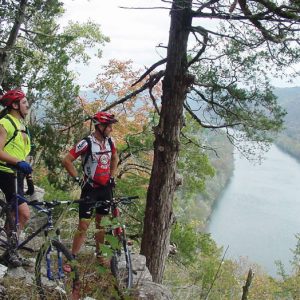calsfoundation@cals.org
Biking
aka: Cycling
Arkansas is home to numerous dirt roads and trails for mountain biking, as well as paved paths and scenic highways for road biking, with nearly year-round use. The state hosts a number of noteworthy tours and competitions for all kinds of bicycling and for all levels of ability.
Arkansas has a very popular series of mountain bike races for both experts and beginners through the Arkansas Mountain Bike Championship (AMBC) Series. Some of the better known are the Attila the Hun and the Womble (Trail) Mountain Bike Classic. Another popular mountain bike trail is the Syllamo trail system north of Mountain View (Stone County), with fifty miles of mostly single-track (wide enough for one bicycle) biking. A trail system at Camp Joseph T. Robinson in North Little Rock (Pulaski County) is maintained by volunteers and can be accessed by checking in at the main gate and purchasing a Sportsmen’s Card. The Ouachita National Forest has 330 miles of mountain bike trails. The Womble and Syllamo are two of over sixty rides rated as “Epic” by the International Mountain Biking Association in the United States.
Arkansas state parks and parks in the larger towns also have mountain-biking trails. Arkansas has scenic, rural, state, and federal highways for day road rides and multi-day tours. Riders can choose from flat rides in the south and east to hilly routes in the western and northern parts of the state. The River Trail in Little Rock (Pulaski County) and North Little Rock is a popular paved, flat route used for recreation and commuting along the Arkansas River and across the Big Dam Bridge, the longest bridge in the United States built specifically for bicycling and walking. Originally a fifteen-mile trail, the River Trail was extended in 2011 with the completion of Two Rivers Bridge to Two Rivers Park, Pinnacle Mountain State Park, and destinations to the west, while the opening of the Clinton Bridge for pedestrians and cyclists that same year provided another river crossing on the eastern end of the trail. The Mississippi River Trail goes ninety-six miles through the state on signed highways from West Memphis (Crittenden County) to Helena-West Helena (Phillips County), with a shorter portion on an alternate route in the southeast corner of the state. The Jonesboro Greenway, a paved trail, will encircle Jonesboro (Craighead County) for twenty-nine miles when construction is completed. The Delta Heritage Trail, a rails-to-trails, crushed-stone route, is being developed from Lexa (Phillips County) to Rohwer (Desha County) and Arkansas City (Desha County); the northern twenty-one miles have been completed as of 2014. On October 22, 2016, Big River Crossing project was opened in West Memphis, which resulted in the Harahan Bridge becoming the longest pedestrian bridge across the Mississippi River and the nation’s largest active rail/bicycle/pedestrian bridge.
Some of the more popular supported and organized road rides are the Tour de Cure, Tour de Rock, and MS 150 charity rides, as well as the Big Dam Bridge (BDB) 100 ride. The BDB ride is the largest in the state with nearly 2,000 riders from thirty states and several foreign countries. The Joe Weber Arky 100 ride in Sheridan (Grant County) is the oldest in Arkansas, having begun in 1971. Many other charity rides throughout Arkansas are run mostly from May through October.
According to a 2013 survey by League of American Bicyclists, Arkansas had made progress in its bicycle-friendly status, going from number fifty to thirty-seven, taking into account factors such as legislation, polices, infrastructure, education, and planning. Local advocacy groups under the banner of Bike/Walk Arkansas give input to state and local governments on bicycling. In 2019, Governor Asa Hutchinson signed into law Act 650, allowing cyclists to treat stop signs as yields and red lights as stop signs.
In 2022, a 177.5-mile bicycle route from Memphis, Tennessee, to Little Rock was officially designated as U.S. Bicycle Route 80. The route goes through a number of historic Arkansas Delta communities, including Marianna (Lee County) and Stuttgart (Arkansas County). Later that same year, the U.S. National Mountain Bike Team announced that they would be based in Bentonville (Benton County) for training in preparation for the 2028 Olympics. This move had occurred following massive investment by the Walton Family Foundation to make northwestern Arkansas more bicycle-friendly.
For additional information:
Adventure Mountain Biking, Arkansas State Parks. https://www.arkansasstateparks.com/activities/biking (accessed July 5, 2023).
Arkansas Bicycle Club. http://www.arkansasbicycleclub.org (accessed July 5, 2023).
Arkansas Mountain Bike Championship Series. http://www.ambcs.com/ (accessed July 5, 2023).
Biking. Arkansas Department of Parks, Heritage and Tourism. https://www.arkansas.com/escape-to-your-natural-state/mountain-biking (accessed July 5, 2023).
Chamberlin, Johnnie. Trails of Little Rock. Little Rock: Parkhurst Brothers, Inc., 2009.
Cochrane, Emily. “How an Arkansas City Became an Epicenter of the Biking World.” New York Times, April 13, 2025. https://www.nytimes.com/2025/04/13/us/how-an-arkansas-city-became-an-epicenter-of-the-biking-world.html (accessed April 14, 2025).
Dillard, Tom. “Climbing aboard the Bicycle Craze.” Arkansas Democrat-Gazette, January 19, 2020, p. 3H.
League of American Bicyclists. http://bikeleague.org (accessed July 5, 2023).
Robinson, Bob. Bicycling Guide to the Mississippi River Trail. Fort Smith, AR: Spirits Creek, 2008.
Willis, James F. “Bicycle Racing in Little Rock, 1885–1898.” Pulaski County Historical Review 70 (Winter 2022): 100–114.
James Britt
Arkansas Bicycle Club
 Recreation and Sports
Recreation and Sports State Parks Division
State Parks Division Big Dam Bridge 100
Big Dam Bridge 100  Syllamo Mountain Bike Trail
Syllamo Mountain Bike Trail 



Comments
No comments on this entry yet.